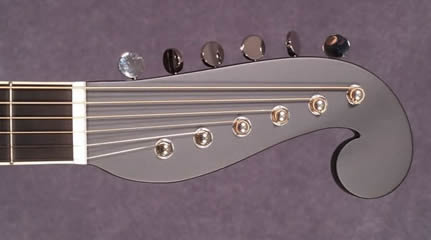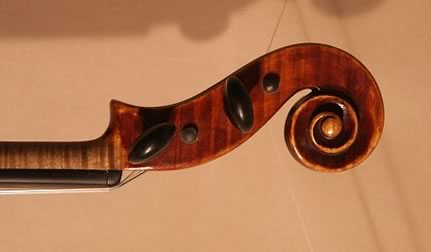Guitar Design 101 – Fender Stratocaster

Why I think the Stratocaster is one of the best designed guitars ever…
My day job is being a graphic designer, which usually entails designing anything from a company logo, window graphics, guitar pedal (hi Tym!) to a coffee bag… basically my job is to make sure stuff looks nice. After doing this for a while you get a sense of what makes a design ‘balanced’… and being a guitar player who’s also a designer I noticed how well thought out the design of the Stratocaster is.
We’ll start from the top. The Stratocaster peghead was originally ‘borrowed’ from Paul Bigsby’s earlier guitar creations…

This in turn was inspired by an early Martin acoustic headstock…

…which again came from the design of a fiddle (violin) headstock that was side on.

Apart from being a classic looking design, the function of this was to give as straight a string pull over the nut as possible, which eliminated the tuning problems Gibson (and everyone else) had with their splayed string spacing.

While I totally agree that Leo Fender probably got the idea from this design from Paul Bigsby, the way they integrated it into the overall design of the Stratocaster was genius. It looked to be a PART of the guitar, not just added on. The reason for this was they designed parts of the guitar around the headstock.

As you can see above, the waist of the Strat lines up with the straight edge of the headstock. The eye automatically draws itself upward from the waist up to the top, and subconsciously makes the connection. The other side of the guitar does the same. This, along with the flat bottom of the Strat, helped the guitar look balanced when upright. As you can also see, the straight lines meet up in the centre of the guitar which helps the guitar look balanced, too. Also, the top horn lines up with the 12th fret so that the guitar balanced perfectly. This had never been done before on any electric guitar, and was discovered in the development of the Precision Bass.

The Stratocaster scratchplate is a design classic in itself. Leo fitted all the electronics to the scratchplate itself. This was Fender’s mass production brain coming into play, but instead of just a slab of plastic fitted to the top of the guitar, the scratchplate followed the curves of the body and added to the futuristic look of the guitar. Remember, this was 1953, the era of Art Deco. Everything was straight lines and sharp angles. The scratchplate was all curves that integrated the electronics beautifully.

The next area is the pickups/pickup selector area. The bridge pickup was angled to add more bass to the high strings and more treble to the low strings. What this also did was follow the line of the volume/tone knobs, which also followed the line of the players arm when strumming.

For the music of the day (country, skiffle) this meant instant control of your sound, instead of reaching across the instrument to change your settings as with the Les Paul. The pickup selector was also angled for swift use in between the song, positioned right under the strumming hand. Another beautiful addition is the input jack socket. This was a totally unique design, with the cable angled so that for convenience the lead could be inserted on the front of the guitar, but would not be hanging out at a 90 degree angle and risked being broken when bumped into something (as on the Gibson SG). The angle of the socket on the body also followed the line of the guitar lead to allow it to wrap gently under the guitar strap.

Then there’s the reason the Strat became so popular in the first place… the synchromatic tremolo. Again, this was a piece of genius design. Before, tremolos (or vibratos) where bulky, heavy things with one spring and no adjustable features. The tuning was also prone to going out after going a bit too hard on the tremolo arm. The Strat tremolo fixed these problems by incorporating the bridge and tremolo into the one unit. Where the Bigsby tremolo still needed the Gibson tune-o-matic bridge, the Strat had it’s own saddles which also happened to have height and intonation adjustable FOR EACH INDIVIDUAL STRING!!! And where the Bigsby had one spring which wasn’t really adjustable (you could get a stiff spring or soft spring.) by taking one or two of the five springs out of the back of the Strat’s tremolo unit you could adjust the level of stiffness that the tremolo had. You could also float the tremolo so that the strings could be bent up and well as down.

One of the most copied parts of a Stratocaster that finds it’s way onto other guitars are the volume and tone knobs. These were totally unique designs that perfectly blended into the white scratchplate, and other makers were quick to use them on their guitars. (especially Japan.) And finally, the amazingly effective rib and forearm carves and radiused edge of the body, which made playing a Strat as painless as possible.
After designing such a work of art, I was confused when I studied the designs of the next few Fender instruments. The Jaguar & Jazzmaster are both unwieldy looking instruments, with tremolo units that are over complicated and are basically a Bigsby and a Gibson Tune-o-matic. After the simplicity and elegance of the Strat’s arrangement, the switching system on these guitars is also confusing (especially the Jag!).

The 1964 Mustang simplified things a little, but the bakelite looking knobs and micro switches also looked like the design was older than the futuristic Stratocaster, which by then was 10 years old. Also, the Mustang’s tremolo system was overly complicated and not as responsive as the previous Stratocaster design.

I don’t think Fender ever really topped the design of the Strat, which after 50 years is still influencing guitar design to this day. From the top horn lining up with the 12th fret (see how many guitars do this), to how many guitars use the Strat’s input jack socket and volume knobs, the Stratocaster IS still a work of art.

awesome article!
i only got my first strat a year or so ago, after playing guitar for 10+ years at that point. i’d only played versions with necks i didn’t like, and passed them off as too common to be interesting! i picked up a ’57 jap reissue, looking just like the one in the photos in your article, and was instantly nuts about it. it feels wonderful to play, after battling with a mustang tremolo for years i am still giddy when i can smash the strats tremolo up and down, with complete control, and remain in tune!
and that fender headstock is the prettiest of them all in my opinion. especially the big fat 70s versions.